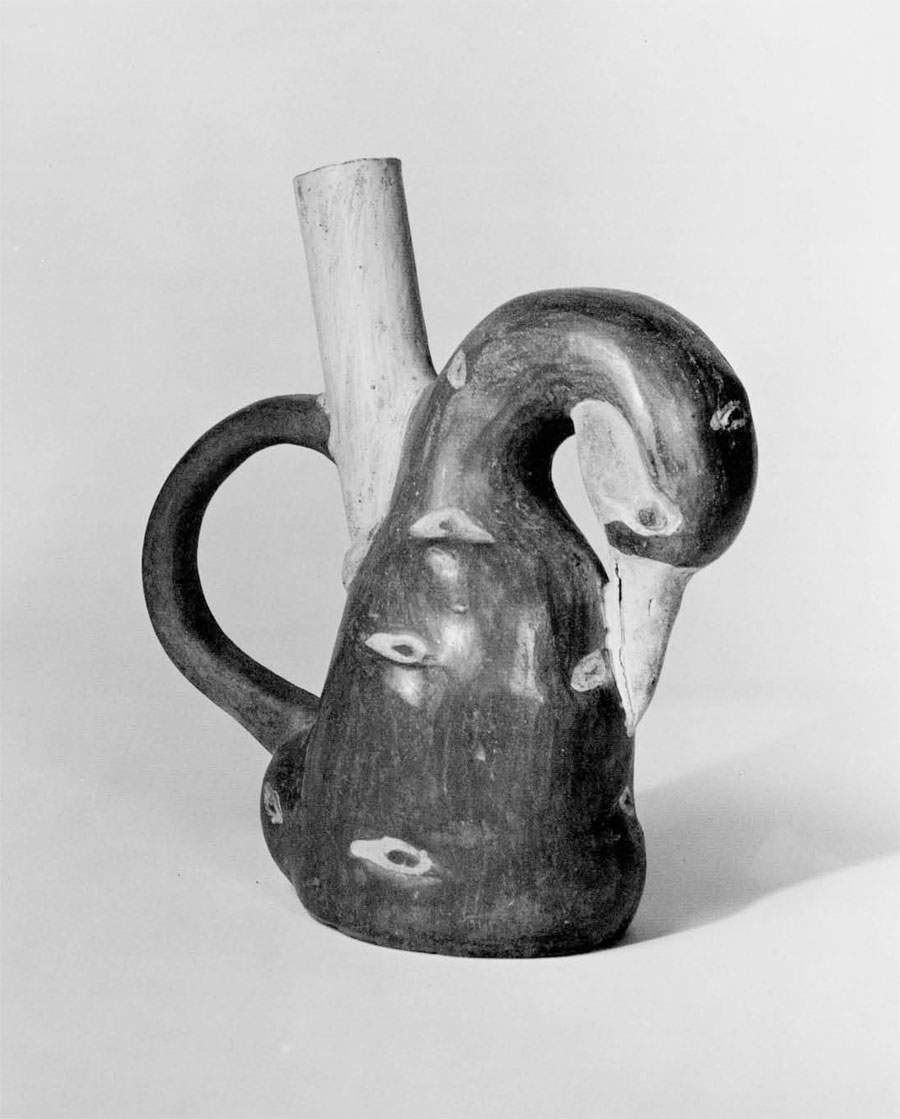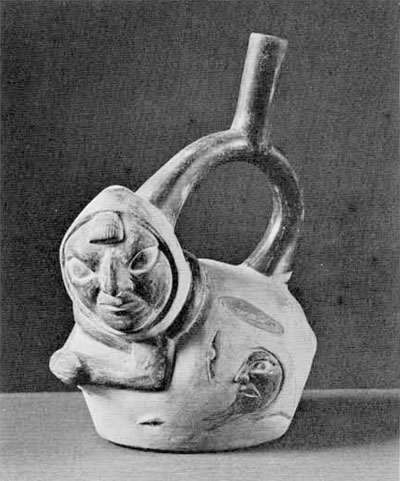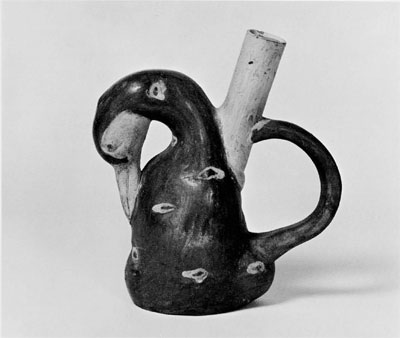
Museum Object Number: 66-10-1
Peru is famous for rich, natural resources, animal, vegetable and mineral, that about in its varied geographical zones from the arid Pacific Coast, over the high Andes and down to the tropical forests of the Amazon basin. The pottery vessel herein illustrated is an example of the depiction of two of these resources in a combination that if not unique was unknown to me before I was fortunate enough to acquire it for the Museum.
When I was in Lima in the late 1930’s, I became acquainted with Dr. Norman Jarvis, a fisheries expert who was staying at the same pension that I was. Dr. Jarvis, as a representative of our Government, was then engaged in helping the Peruvians to develop their commercial fishery. In 1966 Mrs. Jarvis wrote me to ask my advice on the disposal of a small collection of pottery that had been given to her late husband by Peruvian friends. She sent me photographs of the pots, all or which were excellent examples of several typical, major styles, well represented in our collections. The piece that immediately caught my eye was the one we call the “Potato Bird.” It was clearly a product of the Mochica people, who lived on the north coast of Peru in the early centuries of the Christian era. No one who knows anything about Peruvian archaeology could possibly mistake it for anything else, for Mochica pottery was made in only a few basic forms and is typically painted only in brick red and cream or light buff. It also displays an enormous variety of modelled shapes. The Potato Bird falls into the basic class of Mochica vessels characterized by a single upright spout from which a graceful handle curves to meet the body of the pot. This is in contrast to the much more usual “stirrup” spouts, found on a great variety of modelled and painted bases, as for example, in the photograph of the Potato Woman. The parallel-sided spout of the Potato Bird indicates that it was made in the fourth of five phases that have been worked out for Mochica pottery. This would date it roughly at about A.D. 500, although we still lack a satisfactory reliable series of radiocarbon dates for the Mochica culture.
What so much interested me in Mrs. Jarvis’ photograph was what appeared to be the head of a sea bird protruding form a body that seemed to represent a potato. Never having seen this combination of what are fairly common motifs in Mochica art, I visited Mrs. Jarvis at her house in Maryland and convinced myself that the combination really did exist. Mrs. Jarvis very kindly agreed to separate the Potato Bird from the rest of her collection and sell it to the Museum. I then began to search through the hundreds of published illustrations of Mochica pottery. No bird and potato combinations were to be found. In February 1966, on the trip to Peru for Members of the Museum, I went through the collections of the National Museum of Anthropology and Archaeology and the enormous collection of the late Rafael Larco Hoyle, again without finding the combined bird and potato motif. Senor Larco probably had seen more Mochica ceramics than anyone then alive. He told me he had never seen the motif in any of the numerous private collections he knew. I have also asked a number of my colleagues in this country who specialize in Andean archaeology about the motif. None had seen or heard of it. I realize, of course, that similar pots may well exist, but, if so, they must be quite rare. In Mochica art there are many motifs that appear again and again; many of them are combinations that do not exist in nature, and it is a fair assumption that they reflect mythological ideas. I believe, therefore, that the Potato Bird represents a religious concept, in a broad sense, and I find it hard to believe that our single vessel can be its only depiction. My belief is based on the important roles played by the two parts of the combination in Peruvian culture, both in the Pre-Columbian past and to a very considerable degree, in the present.

Museum Object Number: 39-20-32
The white potato was domesticated in the Andes and became one of the most important starch staples of the Indians, especially in the highlands where it can be grown in quantity beyond the limits of maize agriculture. It was also used, and probably grown, on the coast, where there is said to be evidence of its presence, perhaps in a semi-wild form as early as about 2000 B.C. It will be difficult to determine how long ago it was domesticated in the high Andes because conditions for preservation there are poor. We have, however, burnt remains of tubers from the Lake Titicaca region, that are pretty certainly potatoes, at about 300 B.C. There are many Mochica pots modelled in potato form, with the “eyes” clearly shown as in the case of the Potato Bird. Here, they are modelled and picked out in the creamy white of the slip of base paint, over which the brick red of the body and handle was applied. There are small eyes on the bird’s neck and even one in the middle of his forehead.
Historical evidence for the importance of the potato in the economy of the Inca Empire is abundant, and the potato is still the staff of life of highland Indians today. A special, yellowish-fleshed variety is much appreciated on the coast.
Potatoes and other food plants, such as maize and peanuts (of tropical South American origin) were sometimes combined with human beings by the Mochica potters, as in the photograph of the Potato Woman or the Potato Mother. Here the “eyes” in some cases are represented as human faces. This seems to imply strongly that there was more than a mundane relationship between people and major crops, perhaps a supernatural connection reflecting mythological origins of the plants. In short, there is no doubt of the importance of the potato in Andean life for several thousand years.
Sea birds of several species were depicted by the Mochica more frequently than were potatoes, both in modelling and painting. They were also often anthropomorphized, with human arms and legs, as were other birds and animals, again, I should think as reflections of mythology.
There are millions of birds along the coast of Peru who feed on the small fish that swarm in the cold waters of the northward-flowing Peru Current (formerly called the Humboldt Current). This is one of the richest fisheries in the world, producing not only fish but with the help of enormous numbers of birds, many thousands of tons annually of rich fertilizer in the form of guano. Most of this is deposited on islands, just off the coast where the birds roost and nest. Today the guano is harvested scientifically under the control of a government corporation and is used to support the agriculture of the irrigated valleys of the desert coast. It is therefore apparent that there is a strong relationship between the fishery, the birds, and an excellent fertilizer. Just how long the Indians were using guano on their fields we do not know, but the Spanish chroniclers mention its use at the time of the Conquest. There is also good evidence that the Mochica people were familiar with the bird islands and it is at least possible that they used guano in their day.

Museum Object Number: 66-10-1
The bird on our vessel is clearly a gannet or booby (Sula variegata), called piquero, which means “lancer” in Spanish. This is because of their swift, straight, slashing dives. Piqueros are the most numerous of the guano producing birds and are exceeded in guano production only by the cormorants.
If we assume, as I think it is fair to do, that our piquero symbolizes the richness of the sea and , perhaps, with less assurance, the direct connection between guano and agriculture, the combination with the potato makes sense. One can imagine a sort of mystical feeling of awesome respect that the Indians may have felt as they contemplated the vast flocks feeding by the thousands in the sea and returning to their rockeries in lines extending for miles to deposit the guano that enriched their crops. Such feelings could well have inspired the imaginative and charming combination which makes up our Potato Bird.
